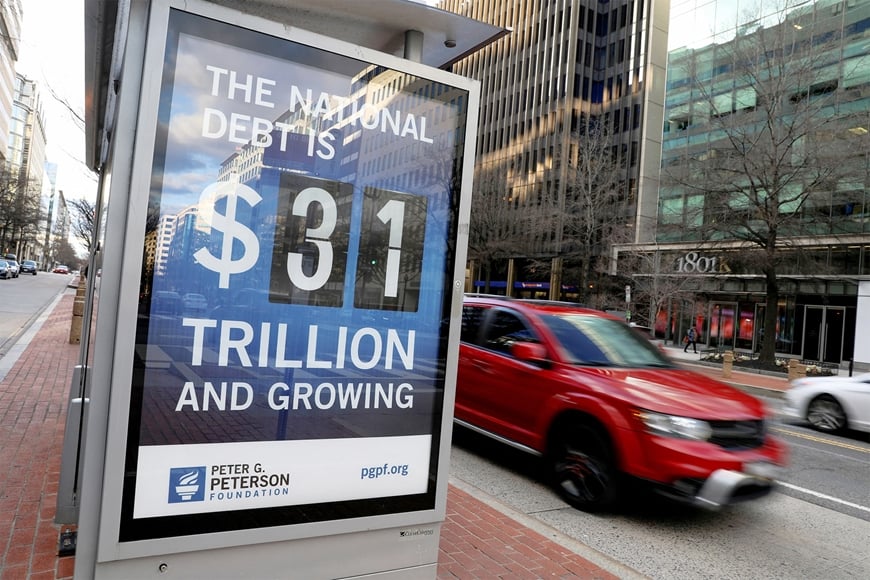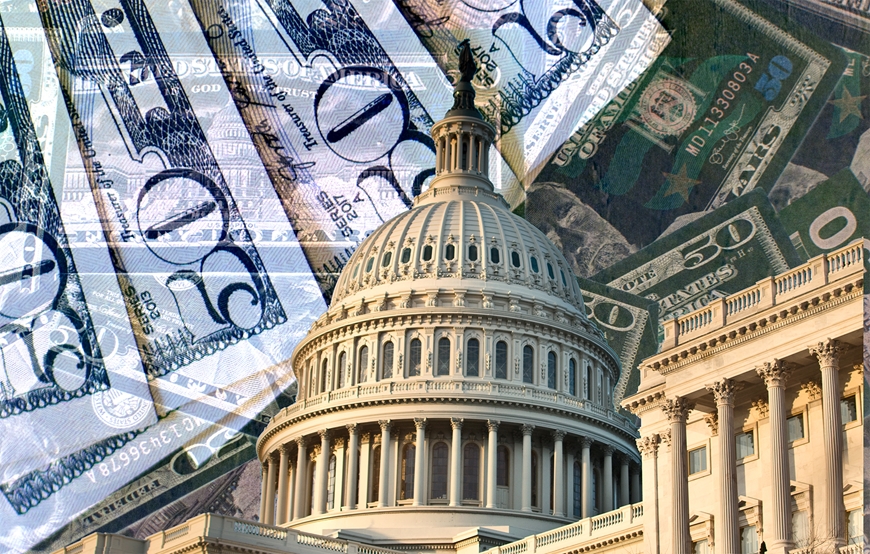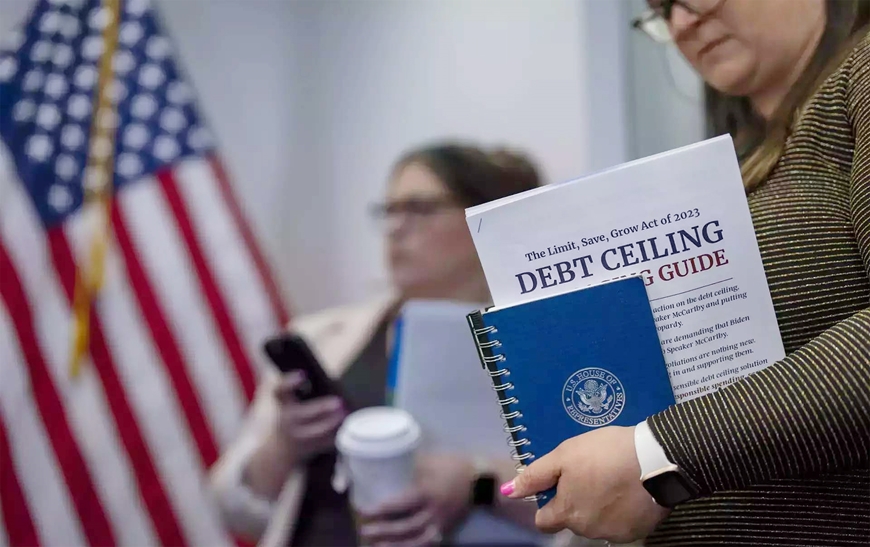The consequences of the first-ever US default scenario after June 1 could quickly spread around the world .
The debt ceiling or debt limit is the legal limit on the maximum amount of money the United States Federal Government is allowed to borrow to pay its debts and expenses. The debt ceiling is set by the United States Congress and has been at $31.4 trillion since January of this year.
 |
| The US debt ceiling has reached its latest threshold since the beginning of this year. Photo: CNBC |
When the government 's debt ceiling reaches its limit, raising it will be put to a vote in Congress and must be approved by both the House and Senate. If lawmakers cannot agree on raising the debt ceiling, Washington could default on its debts.
However, the Republican Party controlling the House of Representatives only agreed to raise the debt ceiling on the condition that the US government significantly cut spending. This met with opposition from the Democratic Party, causing debt ceiling negotiations to fall into a deadlock.
The “red flags”
Analysts and US officials have repeatedly warned about the risk of the country defaulting on its debt if the White House and Congress do not reach an agreement to raise the debt ceiling.
Wall Street would probably be hit first. The shock of defaults would ripple through the financial system (stocks, bonds, mutual funds, derivatives) before spreading to the rest of the economy. Stocks would likely fall sharply in anticipation of a broader recession as interest rates rise and investors pull money out of the market to maintain access to short-term cash. The banking sector, already wary of new lending, could tighten further.
 |
Wall Street could be the first to be affected if the US government defaults. Photo: BusinessLIVE |
No aspect of the global economy will be spared if the US government defaults and the crisis is not resolved quickly, said Mark Zandi, chief economist at financial analysis firm Moody's Analytics.
And if the US government defaults on its debt for much longer, the consequences will be even more dire. Zandi estimates that US economic growth will decline; 7.8 million US jobs will disappear; interest rates will skyrocket; unemployment will rise from its current 3.4% to 8%; and the stock market crash will wipe out $10 trillion in household wealth.
The worry is that much of the financial activity is conducted on the assumption that the United States will always be responsible for all financial risks. U.S. government debt has long been seen as a cornerstone of the global trading system. But a default could disrupt the $24 trillion bond market, freezing financial markets and triggering an international crisis.
Professor Eswar Prasad at Cornell University and senior fellow at the Brookings Institution (USA) said: “Default would be a catastrophic event, with unpredictable impacts, which could seriously affect global financial markets and the US itself.”
The threat has emerged just as the world economy is facing a myriad of threats, from rising inflation and interest rates to the ongoing fallout from the Russia-Ukraine crisis. On top of that, many countries have become skeptical of the outsized role of the United States in global finance.
“Shockwaves” around the world
If the parties fail to reach an agreement on a solution to the current debt ceiling crisis, a worst-case scenario in US history will emerge and the consequences could be huge because the US is the world's largest economy.
Many countries have protected their finances by buying large amounts of U.S. government bonds, which are widely considered to be among the safest assets in the world. But a default could reduce the value of those bonds, damaging many countries’ reserves. That would add to the woes of already indebted countries, as the Federal Reserve’s rate hikes over the past year to curb inflation have eroded the value of U.S. government bonds held by many countries.
 |
| The US debt default scenario is causing many economies around the world to worry about the possibility of a new crisis. Photo: The Hill |
“If the credibility of the US Treasury were to decline for any reason, it would send shock waves through the financial system, with huge consequences for global growth,” said Maurice Obstfeld, an expert at the Peterson Institute for International Economics.
Treasury bonds are widely used as collateral for loans, as a “buffer” against bank losses, as a safe haven, and as a place for central banks to store foreign exchange reserves.
Of all the foreign exchange reserves held by central banks around the world, the US dollar accounts for 58%. The euro is second at 20%. According to the International Monetary Fund (IMF), the Chinese yuan accounts for just under 3%.
Researchers at the Fed calculated that from 1999 to 2019, 96% of transactions in the Americas were denominated in dollars. Outside of Europe, where the euro dominates, the greenback accounted for 79% of trade.
The US currency is so reliable that traders in some unstable economies demand payment in dollars, rather than their own currencies. At the ports of Colombo, for example, shipments pile up because importers do not have dollars to pay suppliers.
Similarly, many stores and restaurants in Lebanon, where inflation is high and the currency is falling, are demanding payment in dollars. In 2000, Ecuador responded to an economic crisis by replacing its currency, the sucre, with the U.S. dollar—a process known as “dollarization.”
Above all, the debt ceiling issue will certainly raise questions about the enormous financial strength of the US and the greenback.
Opportunity for investors?
Even when a crisis originates in the United States, the greenback is always a safe haven for investors. That’s what happened in late 2008, when the collapse of the U.S. housing market brought down hundreds of banks and financial firms, including the once-mighty Lehman Brothers. The value of the dollar soared.
 |
| The US dollar, though still dominant globally. Photo: Morningstar |
If the US exceeds the debt limit without resolving the dispute and the Treasury defaults, the greenback will rise again. Global investors will have nowhere to go except where they always go in times of crisis, and that is the US.”
But the Treasury market could be paralyzed. Instead, investors could move their money into U.S. money market funds or bonds of leading U.S. corporations.
The US dollar, while still dominant globally, has lost ground in recent years as many banks, businesses and investors have switched to the European Union’s (EU) euro and China’s yuan. A rising US dollar could trigger crises abroad by pulling capital out of other countries and increasing the cost of repaying US dollar-denominated loans; particularly if the US uses the strength of the US dollar to impose financial sanctions on other countries as well.
However, so far, no alternative has emerged. Neither the euro nor the Chinese yuan have been able to replace the dollar.
The possibility of a “dark day”
In that context, many Democratic lawmakers have called on President Joe Biden to invoke the 14th Amendment to the US Constitution to help the country escape the risk of default. This is not the first time the 14th Amendment has been mentioned. Former President Barack Obama considered invoking the 14th Amendment twice during his term when the Republican-controlled House of Representatives at that time almost brought the US to the brink of default.
 |
| Many experts predict that the bipartisanship in the US Congress will eventually reach an agreement. Photo: World Day |
There is less than a week left until the deadline for the US Congress to raise the debt ceiling or the country will default. At this point, there is no sign that the US debt ceiling will be raised anytime soon. The risk of default and a temporary US government shutdown is very high.
The economic forecasting and analysis firm Oxford Economics calculates that the US Treasury Department can still afford to pay government expenses through the first half of June, but that is assuming no unusual events occur.
Although acknowledging that the US government could default, many analysts consider this risk low because such a scenario would not benefit any party. According to them, negotiations to raise the public debt ceiling have become a “political weapon” of US parties and that the Republican Party may eventually agree to increase the debt limit after receiving some concessions from President Joe Biden and the Democratic Party.
In the past, US political leaders have often sought to escape raising the debt ceiling before it was too late. According to statistics, the US Congress has increased, amended or extended the borrowing limit 78 times since 1960, most recently in 2021.
MINH ANH (according to AP, Reuters, The Washington Post, CBS News)
Source



























![[Photo] National Assembly Chairman attends the seminar "Building and operating an international financial center and recommendations for Vietnam"](https://vphoto.vietnam.vn/thumb/1200x675/vietnam/resource/IMAGE/2025/7/28/76393436936e457db31ec84433289f72)









































































Comment (0)